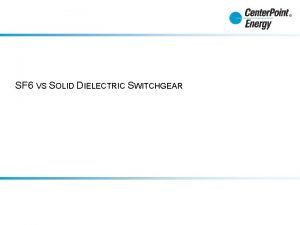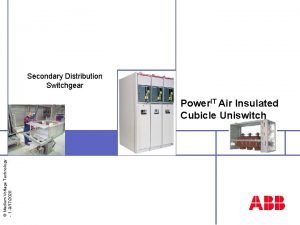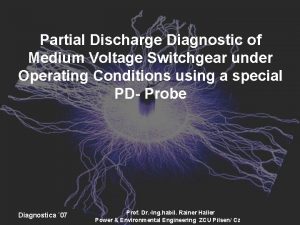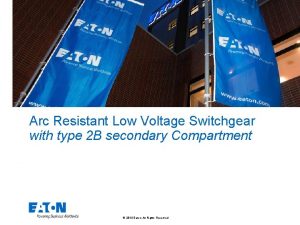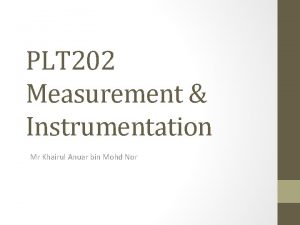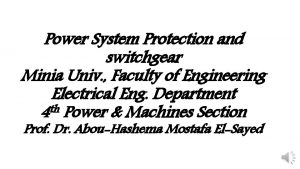POWER SYSTEM PROTECTION SWITCHGEAR Mr Khairul Anuar Mohd































- Slides: 31

POWER SYSTEM PROTECTION & SWITCHGEAR Mr Khairul Anuar Mohd Nor

Simple Calculation of shortcircuit currents • Before selecting proper protective devices, it is necessary to determine the likely fault currents that may result in a system under various fault conditions. • Depending upon the complexity of the system the calculations could also be too much involved. • Accurate fault current calculations are normally carried out using an analysis method called symmetrical components.

• This method is used by design engineers and practicing protection engineers, as it involves the use of higher mathematics. It is based on the principle that any unbalanced set of vectors can be represented by a set of three balanced quantities, namely: positive, negative and zero sequence vectors. • However, for general practical purposes for operators, electricians and men-in-the field it is possible to achieve a good approximation of three-phase short-circuit currents using some very simple methods. These simple methods are used to decide the equipment short-circuit ratings and relay setting calculations in standard power distribution systems, which normally have limited power sources and interconnections.

“Even a complex system can be grouped into convenient parts, and calculations can be made groupwise depending upon the location of the fault. ”

Revision of basic formula It is interesting to note that nearly all problems in electrical networks can be understood by the application of its most fundamental law , Ohm’s law, which stipulates,

Vectors Vector & an AC wave

• In an AC system, it is quite common to come across many voltages and currents depending on the number of sources and circuit connections. • These are represented in form of vectors in relation to one another taking a common reference base. • Then these can be added or subtracted depending on the nature of the circuits to find the resultant and provide a most convenient and simple way to analyse and solve problems, rather than having to draw numerous sinusoidal waves at different phase displacements.

Impedance This is the AC equivalent of resistance in a DC system, and takes into account the additional effects of reactance. It is represented by the symbol Z and is the vector sum of resistance and reactance Impedance relationship diagram

It is calculated by the formula: Z = R + j. X Where R is resistance and X is reactance. • It is to be noted that X is positive for inductive circuits whereas it is negative in capacitive circuits. That means that the Z and X will be the mirror image with R as the base in the above diagram.

Reactance • Reactance is a phenomenon in AC systems brought about by inductance and capacitance effects of a system. Where • f = supply frequency, • L = system inductance • C = system capacitance

Inductive reactance and capacitive reactance oppose each other vectorally; so to find the net reactance in a system, they must be arithmetically subtracted. For example, in a system having resistance R, inductance L and capacitance C, its impedance

When a voltage is applied to a system, which has an impedance of Z, vectorally the voltage is in phase with Z as per the above impedance diagram and the current is in phase with the resistive component. Accordingly, the current is said to be leading the voltage vector in a capacitive circuit and is said to be lagging the voltage vector in an inductive circuit.

Power & Power Factor In a DC system, power dissipated in a system is the product of volts × amps and is measured in watts.

For AC systems, the power input is measured in volt amperes, due to the effect of reactance and the useful power is measured in watts. For a single -phase AC system, the VA is the direct multiplication of volt and amperes, whereas it is necessary to introduce a √ 3 factor for a threephase AC system. Hence VA power for the standard three-phase system is:

Alternatively; Where, • V is in k. V • I is in amps, or Where, • V is in k. V and • I is in k. A. Therefore,

From the impedance triangle below, it will be seen that the voltage will be in phase with Z, whereas the current will be in phase with resistance R Impedance triangle The cosine of the angle between the two is known as the power factor. Examples: • When angle = 0°; cosine 0° = 1 (unity) • When angle = 90°; cosine 90° = 0.

The useful k. W power in a three-phase system taking into account the system reactive component is obtained by introducing the power factor cos φ as below: It can be noted that k. W will be maximum when cos φ = 1 and will be zero when cos φ = 0. It means that the useful power is zero when cos φ = 0 and will tend to increase as the angle increases. Alternatively it can be interpreted, the more the power factor the more would be the useful power.

Put in another way, it is the factor applied to determine how much of the input power is effectively used in the system or simply it is a measure of the efficiency of the system. The ‘reactive power’ or the so called ‘useless power’ is calculated using the formula

In a power system, the energy meters normally record the useful power k. W, which is directly used in the system and the consumer is charged based on total k. W consumed over a period of time (KWH) and the maximum demand required over a period of time. However, the P' or the k. VAR determines the k. VA to be supplied by the source to meet the consumer load after overcoming the reactive components, which will vary depending on the power factor of the system.

Calculation of short-circuit MVA We have studied various types and effects of faults that can occur on the system in the earlier chapter. It is important that we know how to calculate the level of fault current that will flow under these conditions, so that we can choose equipment to withstand these faults and isolate the faulty locations without major damages to the system.

Generally, the worst type of fault that can occur is the three-phase fault, where the fault currents are the highest. If we can calculate this current then we can ensure that all equipment can withstand (carry) and in the case of switchgear, interrupt this current. There are simple methods to determine short-circuit MVA taking into account some assumptions.

Consider the following system. Here the source generates a voltage with a phase voltage of Ep and the fault point is fed through a transformer, which has a reactance Xp Short-circuit MVA calculation

At the time of fault, the fault current is limited by the reactance of the transformer after neglecting the impedances due to cables up to the fault point. Then from Ohm’s law:

Now, Multiplying top and bottom by Xp /Ep × 100 But,

Therefore, Hence, It can be noted above, that the value of X will decide the shortcircuit MVA when the fault is after the transformer. Though it may look that increasing the impedance can lower the fault MVA, it is not economical to choose higher impedance for a transformer. Typical percent reactance values for transformers are shown in the table below.

Reactance % at MVA Rating

“It may be noted that these are only typical values and it is always possible to design transformer with different impedances. However, for design purposes it is customary to consider these standard values to design upstream and downstream protective equipment. ”

Example 1 For the circuit shown below calculate the short-circuit MVA on the LV side of the transformer to determine the breaking capacity of the switchgear to be installed. Short-circuit MVA example

Answer: Therefore, and

Calculate the fault current downstream after a particular distance from the transformer with the impedance of the line/cable being 1 Ω Calculation of fault current at end of cable

Useful formulae Following are the methods adopted to calculate fault currents in a power system. • Ohmic method: All the impedances are expressed in Ω. • Percentage impedance methods: The impedances are expressed in percentage with respect to a base MVA. • Per unit method: Is similar to the percentage impedance method except that the percentages are converted to equivalent decimals and again expressed to a common base MVA. For example, 10% impedance on 1 MVA is expressed as 0. 1 pu on the same base.
 Dr. khairul anuar che azmi
Dr. khairul anuar che azmi Mohd ridzal bin mohd sheriff
Mohd ridzal bin mohd sheriff Dc switchgear abb
Dc switchgear abb Syahid mohd zain
Syahid mohd zain Armyn fahmy mohd fahmy
Armyn fahmy mohd fahmy Mohd talib latif
Mohd talib latif Sarah binti puteh
Sarah binti puteh Kesang leasing sdn bhd v mohd yusof bin ismail
Kesang leasing sdn bhd v mohd yusof bin ismail Prof nazari ismail
Prof nazari ismail Hiley formula malaysia
Hiley formula malaysia Putra mohd aidil rizal
Putra mohd aidil rizal Gayatiri
Gayatiri Wan mohd faizal
Wan mohd faizal Kathrina haji mohd daud
Kathrina haji mohd daud Power trianlge
Power trianlge Simoprime
Simoprime Solid dielectric switch gear
Solid dielectric switch gear Secondary gas insulated switchgear
Secondary gas insulated switchgear Secondary distribution switchgear
Secondary distribution switchgear Partial discharge in medium voltage switchgear
Partial discharge in medium voltage switchgear Paralleling switchgear psg
Paralleling switchgear psg Function of switchgear
Function of switchgear Industrial electric mfg
Industrial electric mfg Abb advance switchgear
Abb advance switchgear Arc duct switchgear
Arc duct switchgear Load interrupter switchgear
Load interrupter switchgear Pz4 switchgear
Pz4 switchgear Abb safelink cb
Abb safelink cb Solid dielectric switchgear
Solid dielectric switchgear Swede conference
Swede conference Generator overvoltage protection
Generator overvoltage protection Power angle curve in power system stability
Power angle curve in power system stability
















